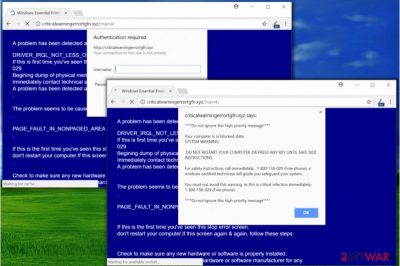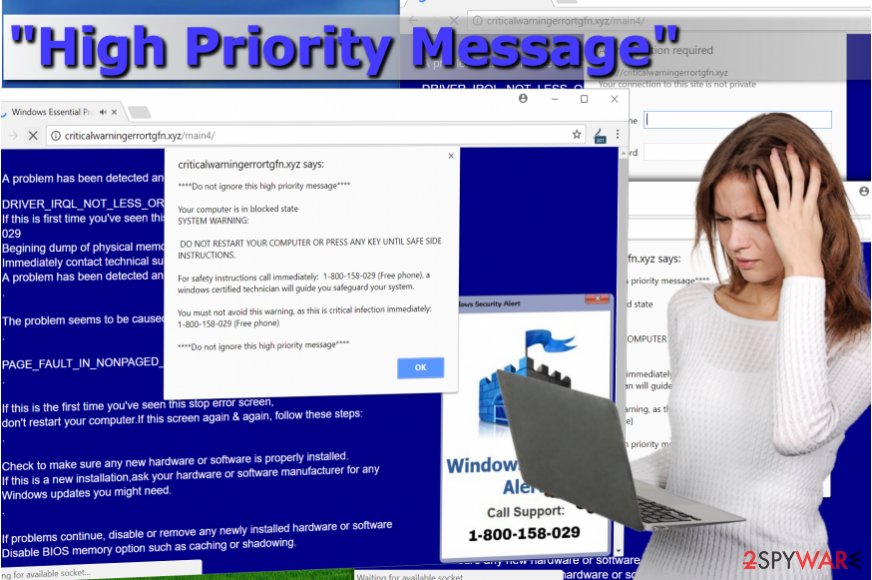“High Priority Message” virus (Improved Guide) - Support Scam
“High Priority Message” virus Removal Guide
What is “High Priority Message” virus?
“High Priority Message” scam wants to trick unsuspecting computer users into calling fraudsters and wasting money on their services

“High Priority Message” alert is a deceptive pop-up that appears on the screen after visiting a phishing website. Such visits might occur due to adware existence on the computer but can also occur after clicking on a malicious online ad[1]. These scam pop-ups say “Do not ignore this high priority message” and repeatedly urge the victim to call a provided “toll-free” number.
It has been noticed that the deceptive tech support scam message comes from Criticalwarningerrortgfn.xyz domain; however, pop-ups displaying similar fake security warnings can be opened by a variety of different scam pages available today.[2] If you noticed a similar warning on your screen, close the browser and check your computer for adware/spyware installed on it. You can use FortectIntego software to scan the computer if you want.
The website behind the “High Priority Message” pop-up says:
A problem has been detected and windows has been shutdown.
DRIVER_IRQL_NOT_LESSOR_EQUAL
If this is first time you’ve seen this screen, contact windows technician: 1-800158-029
Beginning dump of physical memory.
Immediately contact technical support to prevent further damage
A problem has been detected, and Windows has been crash
The rest of the message says that “the problem seems to be caused by the following file: SPCMDCON.SYS” and informs about “PAGE_FAULT_IN_NONPAGED_AREA” issue. However, these issues are invented and do not even exist on your PC. Therefore, you must find and remove “High Priority Message” malware that is trying to convince you to contact tech support scammers.
It is hard to identify which program is causing these deceptive pop-ups, so we recommend using anti-malware software for identification and “High Priority Message” removal. If you haven’t decided what security program you want to use, consider relying on software suggested by our and Zondervirus.nl[3] teams: FortectIntego, SpyHunter 5Combo Cleaner or Malwarebytes.

Deceptive software and their distribution methods
There are thousands of deceptive programs that users install unknowingly. However, there is a way to prevent their installation. You just need to remember the list of things listed below:
- Potentially unwanted programs tend to travel alongside freeware or shareware, so keep that in mind when installing free software downloaded from the Internet. Make sure you choose Custom/Advanced installation settings to see all additional items added to your download and deselect them;
- Software cracks and other illegal software tends to contain malicious files or malware downloaders, so better stay away from them not only to avoid involvement in illegal distribution and use of pirated software but also for your safety;
- Avoid opening questionable email attachments or links sent to you by unknown people.
Keeping the system secured with an anti-malware software is also a very good idea. It helps to automatically ward off suspicious attempts to compromise your system.
Remove “High Priority Message” fake alerts using proper software or manually
You can try to remove “High Priority Message” virus in two ways – manually or automatically. However, we have noticed that many people experience problems when trying to delete the deceptive adware manually, so we assume that tech support scammers continuously change the name of the program and files related to it to avoid detection.
Automatic “High Priority Message” removal option is probably the best choice when trying to delete the described virus from the computer. It also helps to wipe all other dangerous files and programs away at once. If you haven’t decided what program to use for elimination of computer threats, consider checking the list of programs provided below.
You may remove virus damage with a help of FortectIntego. SpyHunter 5Combo Cleaner and Malwarebytes are recommended to detect potentially unwanted programs and viruses with all their files and registry entries that are related to them.
Getting rid of “High Priority Message” virus. Follow these steps
Uninstall from Windows
Eliminate the virus displaying High Priority Message warnings to you by uninstalling suspicious software off your computer immediately.
Instructions for Windows 10/8 machines:
- Enter Control Panel into Windows search box and hit Enter or click on the search result.
- Under Programs, select Uninstall a program.

- From the list, find the entry of the suspicious program.
- Right-click on the application and select Uninstall.
- If User Account Control shows up, click Yes.
- Wait till uninstallation process is complete and click OK.

If you are Windows 7/XP user, proceed with the following instructions:
- Click on Windows Start > Control Panel located on the right pane (if you are Windows XP user, click on Add/Remove Programs).
- In Control Panel, select Programs > Uninstall a program.

- Pick the unwanted application by clicking on it once.
- At the top, click Uninstall/Change.
- In the confirmation prompt, pick Yes.
- Click OK once the removal process is finished.
Delete from macOS
Remove items from Applications folder:
- From the menu bar, select Go > Applications.
- In the Applications folder, look for all related entries.
- Click on the app and drag it to Trash (or right-click and pick Move to Trash)

To fully remove an unwanted app, you need to access Application Support, LaunchAgents, and LaunchDaemons folders and delete relevant files:
- Select Go > Go to Folder.
- Enter /Library/Application Support and click Go or press Enter.
- In the Application Support folder, look for any dubious entries and then delete them.
- Now enter /Library/LaunchAgents and /Library/LaunchDaemons folders the same way and terminate all the related .plist files.

Remove from Microsoft Edge
Delete unwanted extensions from MS Edge:
- Select Menu (three horizontal dots at the top-right of the browser window) and pick Extensions.
- From the list, pick the extension and click on the Gear icon.
- Click on Uninstall at the bottom.

Clear cookies and other browser data:
- Click on the Menu (three horizontal dots at the top-right of the browser window) and select Privacy & security.
- Under Clear browsing data, pick Choose what to clear.
- Select everything (apart from passwords, although you might want to include Media licenses as well, if applicable) and click on Clear.

Restore new tab and homepage settings:
- Click the menu icon and choose Settings.
- Then find On startup section.
- Click Disable if you found any suspicious domain.
Reset MS Edge if the above steps did not work:
- Press on Ctrl + Shift + Esc to open Task Manager.
- Click on More details arrow at the bottom of the window.
- Select Details tab.
- Now scroll down and locate every entry with Microsoft Edge name in it. Right-click on each of them and select End Task to stop MS Edge from running.

If this solution failed to help you, you need to use an advanced Edge reset method. Note that you need to backup your data before proceeding.
- Find the following folder on your computer: C:\\Users\\%username%\\AppData\\Local\\Packages\\Microsoft.MicrosoftEdge_8wekyb3d8bbwe.
- Press Ctrl + A on your keyboard to select all folders.
- Right-click on them and pick Delete

- Now right-click on the Start button and pick Windows PowerShell (Admin).
- When the new window opens, copy and paste the following command, and then press Enter:
Get-AppXPackage -AllUsers -Name Microsoft.MicrosoftEdge | Foreach {Add-AppxPackage -DisableDevelopmentMode -Register “$($_.InstallLocation)\\AppXManifest.xml” -Verbose

Instructions for Chromium-based Edge
Delete extensions from MS Edge (Chromium):
- Open Edge and click select Settings > Extensions.
- Delete unwanted extensions by clicking Remove.

Clear cache and site data:
- Click on Menu and go to Settings.
- Select Privacy, search and services.
- Under Clear browsing data, pick Choose what to clear.
- Under Time range, pick All time.
- Select Clear now.

Reset Chromium-based MS Edge:
- Click on Menu and select Settings.
- On the left side, pick Reset settings.
- Select Restore settings to their default values.
- Confirm with Reset.

Remove from Mozilla Firefox (FF)
Remove dangerous extensions:
- Open Mozilla Firefox browser and click on the Menu (three horizontal lines at the top-right of the window).
- Select Add-ons.
- In here, select unwanted plugin and click Remove.

Reset the homepage:
- Click three horizontal lines at the top right corner to open the menu.
- Choose Options.
- Under Home options, enter your preferred site that will open every time you newly open the Mozilla Firefox.
Clear cookies and site data:
- Click Menu and pick Settings.
- Go to Privacy & Security section.
- Scroll down to locate Cookies and Site Data.
- Click on Clear Data…
- Select Cookies and Site Data, as well as Cached Web Content and press Clear.

Reset Mozilla Firefox
If clearing the browser as explained above did not help, reset Mozilla Firefox:
- Open Mozilla Firefox browser and click the Menu.
- Go to Help and then choose Troubleshooting Information.

- Under Give Firefox a tune up section, click on Refresh Firefox…
- Once the pop-up shows up, confirm the action by pressing on Refresh Firefox.

Remove from Google Chrome
In Chrome, enter chrome://extensions page and delete unwanted extensions that could be displaying the fake pop-ups to you. In addition, reset Chrome to eliminate all suspicious changes to browser settings.
Delete malicious extensions from Google Chrome:
- Open Google Chrome, click on the Menu (three vertical dots at the top-right corner) and select More tools > Extensions.
- In the newly opened window, you will see all the installed extensions. Uninstall all the suspicious plugins that might be related to the unwanted program by clicking Remove.

Clear cache and web data from Chrome:
- Click on Menu and pick Settings.
- Under Privacy and security, select Clear browsing data.
- Select Browsing history, Cookies and other site data, as well as Cached images and files.
- Click Clear data.

Change your homepage:
- Click menu and choose Settings.
- Look for a suspicious site in the On startup section.
- Click on Open a specific or set of pages and click on three dots to find the Remove option.
Reset Google Chrome:
If the previous methods did not help you, reset Google Chrome to eliminate all the unwanted components:
- Click on Menu and select Settings.
- In the Settings, scroll down and click Advanced.
- Scroll down and locate Reset and clean up section.
- Now click Restore settings to their original defaults.
- Confirm with Reset settings.

Delete from Safari
Remove unwanted extensions from Safari:
- Click Safari > Preferences…
- In the new window, pick Extensions.
- Select the unwanted extension and select Uninstall.

Clear cookies and other website data from Safari:
- Click Safari > Clear History…
- From the drop-down menu under Clear, pick all history.
- Confirm with Clear History.

Reset Safari if the above-mentioned steps did not help you:
- Click Safari > Preferences…
- Go to Advanced tab.
- Tick the Show Develop menu in menu bar.
- From the menu bar, click Develop, and then select Empty Caches.

After uninstalling this potentially unwanted program (PUP) and fixing each of your web browsers, we recommend you to scan your PC system with a reputable anti-spyware. This will help you to get rid of “High Priority Message” registry traces and will also identify related parasites or possible malware infections on your computer. For that you can use our top-rated malware remover: FortectIntego, SpyHunter 5Combo Cleaner or Malwarebytes.
How to prevent from getting malware
Choose a proper web browser and improve your safety with a VPN tool
Online spying has got momentum in recent years and people are getting more and more interested in how to protect their privacy online. One of the basic means to add a layer of security – choose the most private and secure web browser. Although web browsers can't grant full privacy protection and security, some of them are much better at sandboxing, HTTPS upgrading, active content blocking, tracking blocking, phishing protection, and similar privacy-oriented features. However, if you want true anonymity, we suggest you employ a powerful Private Internet Access VPN – it can encrypt all the traffic that comes and goes out of your computer, preventing tracking completely.
Lost your files? Use data recovery software
While some files located on any computer are replaceable or useless, others can be extremely valuable. Family photos, work documents, school projects – these are types of files that we don't want to lose. Unfortunately, there are many ways how unexpected data loss can occur: power cuts, Blue Screen of Death errors, hardware failures, crypto-malware attack, or even accidental deletion.
To ensure that all the files remain intact, you should prepare regular data backups. You can choose cloud-based or physical copies you could restore from later in case of a disaster. If your backups were lost as well or you never bothered to prepare any, Data Recovery Pro can be your only hope to retrieve your invaluable files.
- ^ David Bisson. Taboola ads exploited to serve up tech support scams. Graham Cluley. Latest Computer Security News, Opinion and Advice.
- ^ Tech support scams. Microsoft. Windows Defender Security Intelligence.
- ^ ZonderVirus. ZonderVirus. Malware Removal Guidelines, Security Tips & Tricks.























